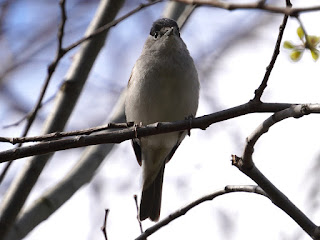A male Starling on a tree near the Speke obelisk sang his whistling, clicking, clattering song. Even if he weren't singing, you could tell that he is male by the blue tinge at the base of his bill. With females, appropriately, it's pink.
A Chiffchaff ...
... and a Blackcap were both singing on the east side of the Long Water.
A Carrion Crow collected swan feathers beside the Round Pond for a comfortable nest lining.
There were very distant views of two kinds of raptor. A Sparrowhawk flew down the Long Water and perched in a Lombardy poplar.
The Peregrines were on the barracks tower, again not on their usual shelf but higher up. The female, on the left, was eating what was probably a Feral Pigeon.
When I got round the other side of the lake hoping for a closer shot they were gone, and a pair of crows were perched on an antenna. They wouldn't have dared if the Peregrines had been there.
A stretch of grass near the Dell which was dug up has been reseeded, inevitably attracting a mob of hungry pigeons. It seems remarkable that any grass comes up at all.
One of the young Grey Herons landed in the nest on the island, displacing a parent who can be partly seen retreating on the left side of the picture.
The pigeon-eating Lesser Black-Backed Gull, over the past few days always seen with his mate, was alone again near the Dell restaurant. Is she nesting on the roof?
A Cormorant at Peter Pan looked glossy in the spring sunshine.
With three pairs of Great Crested Grebes now on the Serpentine there was a lot of territorial manoeuvring, but this splendidly crested male was peacefully fishing under the boat hire platform.
You don't think of Mandarins as diving ducks, but in fact they can dive quite well when they want to reach a strand of algae. This is the pair in the Italian Garden fountain.
When I was photographing this bee on a wallflower in the Rose Garden I thought it was a Honeybee, but at least to my ignorant eyes it looks subtly different, with a broad head, big eyes, heavy backward-curving antennae and narrow regular stripes.
And I haven't a clue what this small one is, a bit further down the border.
Update: Conehead 54 has identified the bees, and the result is interesting. The first one looks like the Mining Bee Andrena flavipes, and the smaller and more colourful one below seems to be its kleptoparasite, the Painted Nomad Bee Nomada fucata. It was only a few feet away, poised to fly over and steal the first one's food.








%20alone%20again%202023%201a.jpg)




Springs here babbayy!!!
ReplyDeleteAbout bloody time too.
DeleteCongratulations. Spring has sprung, finally!
ReplyDeletePeople who can ID any insect on sight have my undying admiration. In my ignorance all I seem able to focus on is how many legs there's on them!
Today's picture of the young Heron is of a piece with yesterday's 'here we go here we go' incredibly expressive pic. I guess the bir
Tinúviel
Half of my comment got eaten. Grrr. I was saying, I guess the bird doesn't yet know how to fully deploy its built-in flaps and slats.
ReplyDeleteTinúviel
No, I've seen those two young herons performing perfect precision landings on post tops and thin branches. And it's certainly possible for a heron to land in a nest without disturbing one already there. I think it's either that the young heron aimed right at its parent as a bit of juvenile horseplay, or that the parent saw it approaching, thought 'Oh no, not that brat again', and fled to avoid being pestered for food.
DeleteFascinating to see your video of the Mandarins diving. I've never seen this behaviour in this species which I encounter frequently. I wonder whether this is learned behaviour from the Coots or Tufted Ducks?
ReplyDeleteThink I can identify your bees- the top looks like the mining bee, Andrena flavipes & believe the more colourful one below is it's kleptoparasite, the Painted Nomad Bee, Nomada fucata.
I've seen various waterfowl including large geese and swans diving surprisingly well when the need arose. I think they can all do it if they want to.
DeleteMany thanks for the identification of the bees, and how interesting. The small one was only a yard away from the big one, perfectly placed to nip over and nick its lunch.